 Winter is a difficult time for pets. Outdoor animals need extra care in order to cope with the cold weather. Special attention should also be paid to older animals, young puppies and animals with short coats.
Winter is a difficult time for pets. Outdoor animals need extra care in order to cope with the cold weather. Special attention should also be paid to older animals, young puppies and animals with short coats.
It is important for all animals to be properly nourished during the winter months. Outdoor animals require about 25 percent more food during the winter months than during warmer months. The increase in food is necessary to generate enough heat for the body to stay warm. Indoor animals often require less food since exercise is generally limited.
Pets require adequate shelter during the cold weather. Outdoor dogs should have an insulated dog house that is protected from the wind. The dog house should not be too large (the heat that the dog generates is used to keep him or her warm) and the opening should face south or southeast. A plastic flap should cover the entrance, especially during windy days. Straw, hay or blankets make excellent bedding material.
Cats generally do not find dog houses very appealing. An small entrance flap (cat door) to the basement of the house, or to the garage, will provide an access to shelter during the cold weather.
Outdoor animals cannot eat snow for a source of water. Clean, fresh water must be provided several times each day. A water heater is a practical solution, however it must be safe and installed properly.
During the cold weather, cats often take shelter under the hood of cars. A warm engine is a comfortable area for a cat to rest. When the car is started, the cat risks severe injuries from the fan belt or blades. Before starting a car, knock on the hood or raise it in order to conduct a safety check.
Paws should be checked regularly during the winter months. Snow and ice should be removed from the fur located between the toes. Damp paws should be thoroughly dried. Moisture that accumulates between the toes can cause sores. Deicing chemicals and salt are common irritants. If these products are commonly used, animals paws should be bathed regularly.
Antifreeze is extremely toxic if ingested by animals. The sweet taste is often appealing to cats and dogs. Antifreeze that is spilled should be cleaned up immediately.
Pets often experience dry skin during the winter months. Lack of humidity tends to dry the skin. Frequent grooming (brushing) helps stimulate the production of oil from the skin glands.
Occasionally an animal is accidently left outdoors for an extended period of time. As a result, frostbite may occur. The most common areas for frostbite are the tips of the ears, paw pads, and the tip of the tail. The frostbite area should be bathed in warm water (not hot) then the animal should be taken to a veterinary hospital.
Kindness is the best care for animals during the winter months. If the temperature drops below 15 degrees F., the pet should be moved indoors. If an animal is shivering or refuses to play, this generally means that he or she is too cold. This animal should be brought indoors.
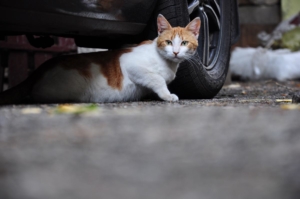 Antifreeze and windshield washer fluids contain a product called ethylene glycol. Ethylene glycol is sweet and has a taste that is attractive to both dogs and cats. Just a small amount of antifreeze consumed by a pet can cause irreversible kidney damage, leading to coma and death.
Antifreeze and windshield washer fluids contain a product called ethylene glycol. Ethylene glycol is sweet and has a taste that is attractive to both dogs and cats. Just a small amount of antifreeze consumed by a pet can cause irreversible kidney damage, leading to coma and death.
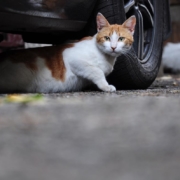

 On a recent visit, Debby’s sister tried to talk her into adopting a kitten. Debby loves animals, but didn’t really need another cat, and she had her sales resistance at a high level. She left for the drive back to Clarkston without a new kitten… At least she thought.
On a recent visit, Debby’s sister tried to talk her into adopting a kitten. Debby loves animals, but didn’t really need another cat, and she had her sales resistance at a high level. She left for the drive back to Clarkston without a new kitten… At least she thought.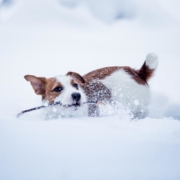
 The cold months present a problem for outdoor dogs. During the winter, outdoor pets are particularly susceptible to dehydration. Since small bowls of water freeze quickly, twice-a-day watering is not sufficient. We recommend a large, deep, plastic bowl, since a large deep bowl of water freezes more slowly than a small, shallow one. A plastic bowl is more efficient than a metal one. Metal has a tendency to loose heat more quickly. In subzero temperatures or situations where the water cannot be changed several times a day, a livestock water bucket heater is useful.
The cold months present a problem for outdoor dogs. During the winter, outdoor pets are particularly susceptible to dehydration. Since small bowls of water freeze quickly, twice-a-day watering is not sufficient. We recommend a large, deep, plastic bowl, since a large deep bowl of water freezes more slowly than a small, shallow one. A plastic bowl is more efficient than a metal one. Metal has a tendency to loose heat more quickly. In subzero temperatures or situations where the water cannot be changed several times a day, a livestock water bucket heater is useful.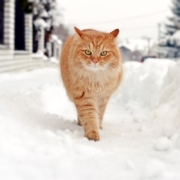
 During the winter months, dogs’ paws are often swollen and irritated. Examination of the interdigital (between the toes) area reveals red, inflamed skin. This condition is often very painful, causing the dog to walk with a limp.
During the winter months, dogs’ paws are often swollen and irritated. Examination of the interdigital (between the toes) area reveals red, inflamed skin. This condition is often very painful, causing the dog to walk with a limp.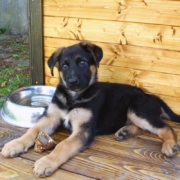
 Most dogs can live outdoors, even during the winter months. Some breeds do not tolerate the cold very well and should not live outdoors. (Whippets, Italian Greyhounds, chihuahua, etc.) These dogs cannot tolerate the cold for long periods of time and develop hypothermia very quickly. Large dogs living outdoors should have a cozy, insulated dog house. The house should not be too large, just large enough for your dog to stand up and turn around. A dog house that is too large will lose heat quickly. The house can be homemade; however, new insulated plastic models are available and reasonable in price.
Most dogs can live outdoors, even during the winter months. Some breeds do not tolerate the cold very well and should not live outdoors. (Whippets, Italian Greyhounds, chihuahua, etc.) These dogs cannot tolerate the cold for long periods of time and develop hypothermia very quickly. Large dogs living outdoors should have a cozy, insulated dog house. The house should not be too large, just large enough for your dog to stand up and turn around. A dog house that is too large will lose heat quickly. The house can be homemade; however, new insulated plastic models are available and reasonable in price.
 Winter is a difficult time for pets. Outdoor animals need extra care in order to cope with the cold weather. Special attention should also be paid to older animals, young puppies and animals with short coats.
Winter is a difficult time for pets. Outdoor animals need extra care in order to cope with the cold weather. Special attention should also be paid to older animals, young puppies and animals with short coats.